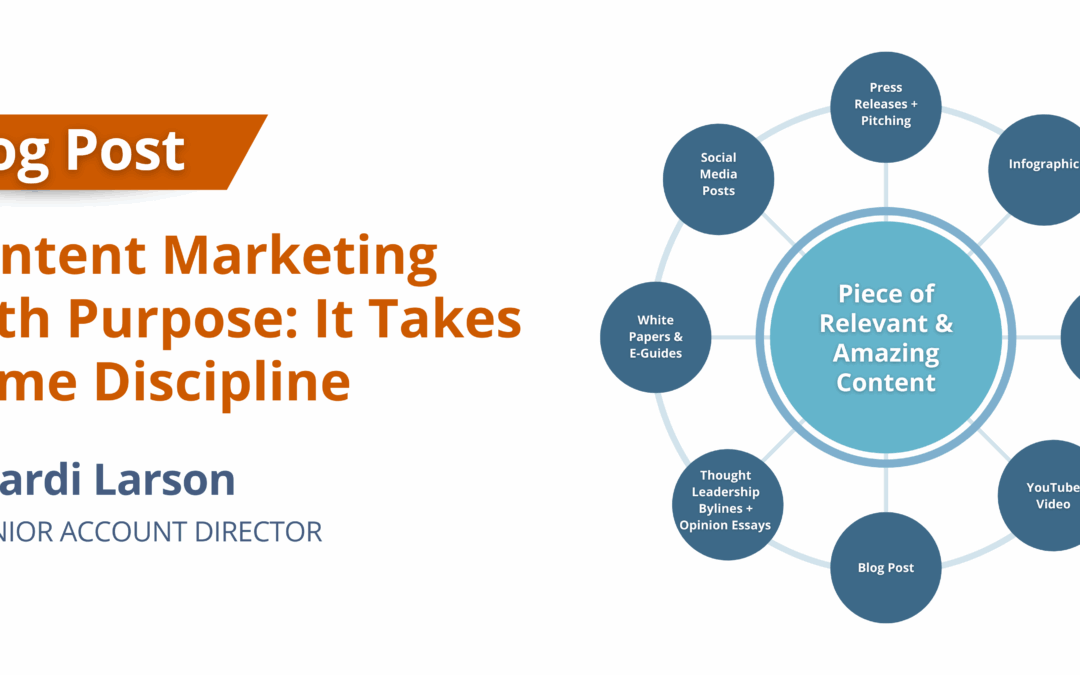
by Morgan Lewis | Aug 20, 2025 | Blog
In 2025, decision-makers running health systems, physicians’ practices, insurers and life science companies have more demands on their attention than ever. Yet, even today, these leaders continue to seek out and read thought leadership articles to gain insight into the challenges facing their organizations.
Given their potential influence, these articles continue to play a valuable role as part of an integrated and multifaceted PR/marketing campaign. At Amendola, we regularly help clients craft compelling bylines that resonate with both readers and trade publication editors. But we still wanted to do a pulse check to determine what truly distinguishes one byline from another.
To explore this question, we recently ran a poll on LinkedIn asking: Which of these three is most crucial for getting published and engaging readers when writing thought leadership?
Here’s how the votes broke down:
- Focus on an industry problem: 77%
- Go easy on the self-promo: 15%
- Respect your readers’ time: 8%
Focusing on industry challenges took the top spot by a mile. Still, all three elements are nonetheless essential to thought leadership content that captures attention, builds authority, and clears editorial hurdles. Here’s a closer look at why each matters and how to ensure your bylines accurately reflect them.
Focus on an Industry Problem
The clear winner of our poll, this audience-focused approach centers on their needs and pain points. It is clear from the results that trusted thought leadership should not necessarily be about what your organization wants to say, but rather, what your audience needs to hear.
Editors prioritize content that informs and helps readers do their jobs better. If a byline sheds light on a genuine industry challenge, such as data silos hindering improvements in care quality and outcomes or the slow adoption of AI due to regulatory uncertainty, it immediately signals relevance.
Similarly, in our experience, the best-performing bylines from our health-tech and life-science clients have been those that closely align with the most pressing issues faced by providers, payers, pharmaceutical leaders, or other health IT buyers. For example, instead of broadly discussing the benefits of remote patient monitoring, a more valuable angle would be to examine how payers are adjusting their reimbursement models in response to regulatory uncertainty and what that means for provider adoption at scale.
In most cases, this approach means you should start your byline by identifying a pressing question or problem. If you are unsure about which issue will resonate most, start listening to your customers, the news, and the conference sessions that everyone is buzzing about. The more you anchor your thought leadership in the day-to-day challenges of your audience, the more likely it is to resonate and get published.
Go Easy on the Self-Promo
While only 15% of poll respondents chose minimal-to-no self-promotion as the most crucial trait of published thought leadership, it remains a major factor in whether an editor accepts or rejects a byline. Many otherwise strong pieces lose credibility when they shift from insight-sharing to sales-pitching.
The line between thought leadership and marketing copy is often thin, but it is critical. Readers come to trade publications for insight, not product brochures. Of course, your leaders should still showcase their expertise, but it needs to be demonstrated through stories, lessons learned, or innovative thinking, not direct promotion.
For example, if your company recently led a project that improved medication reconciliation accuracy, open the article by focusing on the broader issue: the clinical and safety consequences of poor medication data. Then, explain how to identify and solve the problem, sharing generalizable insights that other health systems or vendors could apply.
Ultimately, the goal is to earn trust, which is built by offering something of value without strings attached.
Respect Your Readers’ Time
Although this characteristic received the fewest votes in our poll, it should not be underestimated. Clarity and conciseness are the unsung heroes of persuasive writing.
Your audience is busy. They may be reading between meetings, during a quick coffee break, or in the few quiet minutes before their next patient or pitch. A strong byline makes their time feel well spent. That means using plain language, avoiding unnecessary tangents, and structuring your argument in a way that is easy to follow.
In technical fields such as health tech or clinical innovation, it may be especially tempting to showcase expertise through complex language. However, the best thought leaders recognize that simplicity is indeed a strength. One compelling idea, clearly expressed, will consistently outperform three half-developed ones wrapped in buzzwords.
If your byline cannot be understood by an intelligent, time-pressed reader in a few scrolls or less, it is time to revise.
Bringing It All Together
Albeit unscientific, our poll results reinforce what we have long known from working with leading trade and consumer publications: the strongest bylines solve real problems, put the reader first, and let the value of the insight speak louder than the brand behind it.
In a time where healthcare leaders are navigating unprecedented complexity and constant change, the value of strong thought leadership cannot be overstated. Articles that identify real challenges, offer informed perspectives, and respect the reader’s time stand a far better chance not only of being published but also of being read, remembered, and shared. Whether written by an executive, subject matter expert, or seasoned communicator, the best thought leadership doesn’t just fill space, it fuels meaningful dialogue across the industry and elevates your company’s profile in the market.

by Mardi Larson | Jul 23, 2025 | Blog
In today’s fast-moving digital world, content marketing takes some discipline. You can’t rely on great content alone — it demands structure, consistency, and a results-driven mindset. To establish true thought leadership and maintain brand credibility over time, organizations must adopt a rigorous approach to content planning, creation, and distribution. Below are some proven best practices that can help advance your overall content marketing program from good to great.
- Develop an Editorial Calendar – Plan your content ahead of time, aligning with product/service launches, company or industry events, webinars, speaking engagements, and more. Don’t forget strategically aligned social holidays, which can help drive engagement.
- Be Helpful and Educate – Drawing from your ideal customer profile and target personas, think through their pain points and what your product or service helps them solve. Think through the questions they ask themselves every day and answer them! Driving out educational and informative content is a great way to position your organization as a thought leader and the go-to resource for smart, useful content.
- Be Relevant – Track the trends and news events in your industry and reference and tie to these regularly. Consider a weekly insights column or quarterly report to curate the top trends to watch with your take on why it matters.
- Create a distribution tip sheet or checklist – Develop a PESO-based content distribution framework specific to your company and refresh it quarterly. I call it this the “Content Marketing Wheel.” Pull it out and review it for each new content opportunity. There are now more channels than ever before from news releases to YouTube and this tool will help you think through the opportunities well suited for each piece of content.
- Monitor and Measure – Use analytics tools to track engagement, media mentions, and conversion rates. Regularly analyze these metrics – some of the best content marketers do this daily! Assess and adjust your content marketing strategy based on channel performance.
- Engage with Industry Influencers – Build relationships with journalists, analysts, and other industry thought leaders to enhance your reach. Foster collaborative opportunities for content co-creation such a joint webinar or co-authored thought leadership article with a business partner — 1+1=3!
- Encourage Employee Advocacy – Empower employees to share content on their professional networks to expand visibility, credibility and optimize content reach. Leverage internal experts and lift them up as brand ambassadors to enhance the credibility of the expert and the organization.
Maximizing Earned Content – Four Key Tips
Earned content — media coverage, awards, analyst reports, and speaking opportunities — is one of the most credible forms of content, but it’s often underleveraged in content marketing and the PESO model. The key to maximizing earned media is following a “create once, share everywhere possible” approach:
- Repurpose Media Coverage – If your company is featured in an article or analyst report, don’t just let it sit on the website of that publication or firm. Share it across your company’s blog, social media channels, and presentation decks. When sharing via blog post, include additional commentary to showcase your expert insights and include a backlink to the article or report. Backlinks to reputable media outlets bolster your website’s authority ranking on search engines like Google.
- Leverage Awards and Recognition – If your company wins an award, create a news release and issue it on a wire service, share the news on social media, update your website, and include it in email campaigns. Consider running a paid campaign sharing this exciting news. Recognition builds credibility, but only if people know about it.
- Maximize Speaking Engagements – When a leader from your company speaks at an event, record it, create short video clips for social media, and repurpose key takeaways into a post or infographic for your company’s blog. Consider turning the presentation content into a LinkedIn article series, a webinar or a podcast episode for additional mileage. Don’t forget to do a news release covering the speaking engagement either before the event or after and be sure to include details and key callouts from the high-value presentation itself.
- Cross-Promote on Different Channels – Content should not exist in silos. Leverage your high-value content everywhere possible. Reinforce thought leadership by integrating earned content across the many channels you have available to you. When you get a piece of high-value earned media coverage, pull out your Content Marketing Wheel to decide where to share it.
Make Every Piece of Content Count
Be disciplined, stay proactive, and always look for ways to get more mileage out of every single piece of content you create.
Great content doesn’t just inform — it influences, builds trust, and opens doors. By applying structure to your content marketing strategy and embracing a disciplined, PESO-aligned approach, you can unlock the full value of every asset you create. Always ask: how can we make this content piece go further?
If you’re looking to bring more rigor and results to your content marketing, the A-Team is here to help. From strategy to execution, we know how to make your content work harder — and smarter — for your brand or business.

by Administrator | Jul 21, 2025 | News
Initiative to raise awareness of Elemeno’s innovative point-of-care support via strategic media relations, social media and targeted content
OAKLAND, Calif., and SCOTTSDALE, Ariz., July 22, 2025 — Elemeno Health, a market leader in just-in-time microlearning solutions for frontline staff, today announced it has selected Amendola, part of Supreme Group, to create and lead its integrated public relations and thought leadership program. The program will spotlight Elemeno’s transformative role in equipping frontline healthcare workers with just-in-time learning at the point of care.
Built by clinicians for clinicians and trusted by over 70 hospitals nationwide, Elemeno Health delivers bite-sized, cloud-based microlearning and communication solutions tailored to care team needs—bridging the gap between knowledge and action. By offering customized content accessible on any device, Elemeno enables frontline staff to provide safer, more efficient, and standardized care.
Amendola’s integrated PR program will include media outreach, thought leadership campaigns, social media, and content strategy — all amplifying Elemeno’s voice in the conversation around frontline empowerment and quality improvement.
“Elemeno is transforming how healthcare teams access and apply critical knowledge,” said Tim Coulter, CEO of Elemeno Health. “To reach the next level of impact, we needed a PR partner who can articulate our value to health systems nationwide. Amendola’s track record in healthcare tech and its deep industry expertise made the decision easy.”
This is the third time Coulter has worked with Amendola, a reflection of the results the agency has delivered.
“Tim’s recent appointment as CEO signals a new phase of growth for Elemeno, as the company positions itself for aggressive growth and expansion across hospitals and health systems,” said agency president Jodi Amendola. “Their microlearning model is intuitive, scalable, and incredibly relevant in today’s high-pressure care environments. We’re looking forward to telling their story and sharing their incredible value proposition with those who need it most.”
About Elemeno Health
Founded by clinicians in 2016, Elemeno Health is a Public Benefit Corporation that empowers frontline staff with just-in-time microlearning technology at the point of care. Its cloud-based platform replaces binders, emails, and document storage systems with team-specific content in bite-sized formats, consumable in the flow of work. Elemeno complements existing LMS/training systems, promoting knowledge retention, enabling standardized delivery of best practices, and improving system-wide care quality. Trusted by 70+ hospitals nationwide, Elemeno Health enhances operational efficiency and patient safety at scale. To learn more, visit www.elemenohealth.com.
About Amendola
Amendola, part of Supreme Group, is an award-winning, insights-driven public relations and marketing firm that integrates media relations, social media, content, and lead gen programs to move healthcare, life sciences/pharma and healthcare IT decision-makers to action. The agency represents some of the industry’s best-known brands as well as groundbreaking startups disrupting the status quo. Nearly 90% of its client base represents multi-year clients and/or repeat client executives. Amendola’s seasoned team of PR and marketing pros understand the ongoing complexities of the healthcare ecosystem and provide strategic guidance and creative direction to drive positive ROI, boost reputation and increase market share. Making an impact since 2003, Amendola combines traditional and digital media to fuel meaningful and measurable growth. For more information about the industry’s “A-Team,” visit this website and follow us on LinkedIn.
Media Contact: Marcia G. Rhodes / mrhodes@acmarketingpr.com
# # #

by Mardi Larson | Jul 9, 2025 | Blog
Content marketing is a specialized function of marketing that focuses on creating, publishing, and distributing valuable, relevant, and high-value content to attract and engage target audiences. Having been in strategic communications roles for more than three decades, I embrace this model as the modern version of yesteryear’s “integrated communications” approach, where we ensured that content was widely distributed and shared across all the communications channels available to us. Back then there were only a handful of channels where today new channels are popping up every nanosecond, making content marketing programs more opportunistic and increasingly complicated all at the same time.
Content marketing is a smart approach for companies of all sizes, including early stage and maturing companies that want to establish themselves as thought leaders, as well as to build trust, establish industry authority, generate leads, and ultimately drive profitable customer engagements.
Content marketing is both an art and a science.
It requires creativity to craft compelling stories with helpful information that’s search engine optimized, as well as the discipline to ensure that content is planned out and effectively distributed and leveraged across all communications channels for maximum impact. In today’s fast-paced digital media landscape, simply creating great content and posting it on a company blog isn’t enough. You need a disciplined approach to ensure the great content you worked so hard to create reaches audiences across all the ever-evolving channels available.
I have a mantra – create once, publish and post everywhere possible. The art of repurposing content across all the channels is important. Communications pieces shouldn’t be siloed, they should be shared.
That’s where the PESO model comes in.
Understanding the PESO Model
The PESO model stands for Paid, Earned, Shared, and Owned and it is a structured framework for content distribution that ensures your content gains maximum exposure. Let’s break down PESO across the four areas and the common channels and forums within each.
- Paid Media includes traditional and digital advertising where companies pay for visibility. It quickly expands reach, driving targeted website traffic and increasing brand awareness. Common paid media channels include:
- Social media ads (Facebook, LinkedIn, Instagram, TikTok, etc.)
- Pay-per-click (PPC) search engine advertising
- Display advertising (banner ads, retargeting, and programmatic ads)
- Sponsored content and paid influencer partnerships
- Streaming ads on Hulu, NetFlix, Amazon Prime, etc.
- Traditional media such as TV, radio, billboards
- Earned Media is exposure gained through third-party entities. Earned media is just that – earned (not paid for). And it’s one of the most credible forms of media in the PESO model. It comes from external sources that provide the added value of independent validation for your company – its expertise, opinion, innovation or product. Earned media includes:
- Press coverage (features, quotes, and mentions in the media)
- Industry awards and recognitions
- Speaking engagements at conferences and industry events
- Coverage in industry analyst reports and recommendations
- Shared Media involves organic content distribution through social engagement. Shared media is a critical component for consumer brands and is often an underutilized area for B2B companies. This includes:
- Social media shares and engagements
- User-generated content (customers organically sharing experiences with your brand)
- Brand/company mentions and hashtags
- Organic, non-paid influencer engagement
- Community discussions (LinkedIn groups, Reddit, industry forums)
- Owned Media refers to content that a company owns and thus directly controls. These channels are essential because they allow companies to manage their messaging, share stories and provide valuable resources to their audiences. Examples include:
- Blog posts and company website content
- Whitepapers, case studies, e-books, infographics, reports and other informational resources
- Webinars, podcasts, and newsletters
- Sales presentations and corporate reports
- News releases
For a content marketing strategy to be successful, all four PESO areas and the many channels and forums nested within each should be considered.
Don’t just do a webinar – leverage the content across as many channels as possible. Don’t just do a news release on a news wire service, create a blog about bylined directly from an on-staff expert offering a personal perspective, post it to your newsroom and create social media posts. And that high-value earned media coverage, share it everywhere – work it into speaking engagements, awards applications, sales presentations, marketing collateral, social media channels, investor decks and more.
Content marketing isn’t just about creating high-impact and useful content – it involves strategic distribution and integration across multiple communication channels and touchpoints. By following the PESO model and maximizing earned media through smart distribution, companies can enhance their credibility and position themselves as true industry thought leaders. Their companies will come up more easily in online traditional and generative search, which is powerful for any B2B thought leadership brand.

by Administrator | Jun 17, 2025 | News
Partnership to elevate awareness of Motive’s groundbreaking physician-level performance measures, value-based care leadership
SAN FRANCISCO and SCOTTSDALE, Ariz. – June 17, 2025 – Motive Medical Intelligence (Motive), a leading healthcare data and analytics company advancing physician-level performance and value-based care, today announced that it has selected Amendola, part of Supreme Group, to create and lead its integrated public relations and thought leadership program. Amendola will spotlight Motive’s Practicing Wisely solution and position the company’s experts to expand its reach across the healthcare industry.
“At Motive, we’re reimagining how evidenced-based healthcare data can empower physicians and transform care delivery,” said Jeanne Cohen, CEO and Founder of Motive Medical Intelligence. “To bring that vision to life at scale, we knew we needed a communications partner who shares our passion for innovation and understands the broader impact of value-based care. Amendola stood out for their strategic insight, storytelling excellence, and deep roots in healthcare. Together, we’re not just raising awareness—we’re building momentum for real change in the industry.”
Practicing Wisely is the only clinical analytics system designed to evaluate performance and improvements at physician and group levels using Appropriateness of Care, Quality, and Waste measures across 18 specialties as well as primary care and pediatrics. It is widely used by top payers and providers committed to reducing low-value services and advancing value-based care.
“Motive is redefining how the healthcare industry understands and improves clinical performance to drive the healthcare ecosystem’s commitment to value-based care,” said Jodi Amendola, president of Amendola. “The healthcare industry is ripe for broader adoption of the Practicing Wisely system, which is the result of deep clinical and technical expertise.”
Amendola added, “Now is the time to showcase the Motive team’s powerful work, expertise, and thought leadership to guide the industry to the future. Motive is exactly the kind of visionary client we’re proud to support.”
About Practicing Wisely
The proprietary solution is powered by technology that delivers defensible, auditable insights based on clinical guidelines and evidence. Every measure is delivered with clear rationale, supporting materials such as clinical guides and evidence, and engagement strategies to foster physician and group improvement to build payer-provider trust. It is designed to support, not penalize, physicians, while helping all healthcare stakeholders align around shared goals in value-based care.
About Motive Medical Intelligence Motive is redefining healthcare performance analytics with an emphasis on transparency, physician trust, and real-world actionability. With nearly 30 years of experience and no direct competitors matching its scope or precision, Motive is the partner of choice for organizations committed to eliminating low-value care and thriving in value-based care models. Through its proprietary Practicing Wisely solution, Motive is helping the industry eliminate the $390 billion in annual waste in the U.S. health system, advancing the transition to high-value, patient-centered care, and achieving the quadruple aim. Learn more here.
About Amendola Amendola, part of Supreme Group, is an award-winning, insights-driven public relations and marketing firm that integrates media relations, social media, content, and lead gen programs to move healthcare, life sciences/pharma and healthcare IT decision-makers to action. The agency represents some of the industry’s best-known brands as well as groundbreaking startups disrupting the status quo. Nearly 90% of its client base represents multi-year clients and/or repeat client executives. Amendola’s seasoned team of PR and marketing pros understand the ongoing complexities of the healthcare ecosystem and provide strategic guidance and creative direction to drive positive ROI, boost reputation and increase market share. Making an impact since 2003, Amendola combines traditional and digital media to fuel meaningful and measurable growth. For more information about the industry’s “A-Team,” visit this website and follow us on LinkedIn.
Media Contact: Marcia Rhodes/mrhodes@acmarketingpr.com
# # #




